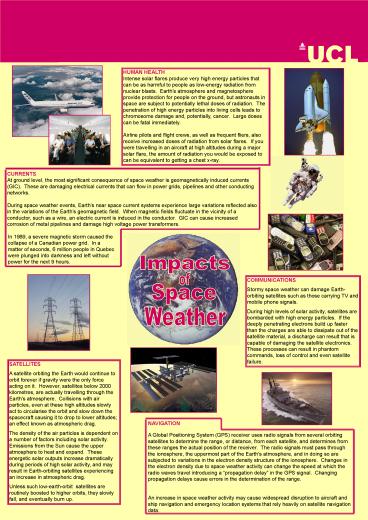HUMAN HEALTH PowerPoint PPT Presentation
1 / 1
Title: HUMAN HEALTH
1
HUMAN HEALTH Intense solar flares produce very
high energy particles that can be as harmful to
people as low-energy radiation from nuclear
blasts. Earths atmosphere and magnetosphere
provide protection for people on the ground, but
astronauts in space are subject to potentially
lethal doses of radiation. The penetration of
high energy particles into living cells leads to
chromosome damage and, potentially, cancer.
Large doses can be fatal immediately. Airline
pilots and flight crews, as well as frequent
fliers, also receive increased doses of radiation
from solar flares. If you were travelling in an
aircraft at high altitudes during a major solar
flare, the amount of radiation you would be
exposed to can be equivalent to getting a chest
x-ray.
CURRENTS At ground level, the most significant
consequence of space weather is geomagnetically
induced currents (GIC). These are damaging
electrical currents that can flow in power grids,
pipelines and other conducting networks. During
space weather events, Earths near space current
systems experience large variations reflected
also in the variations of the Earths geomagnetic
field. When magnetic fields fluctuate in the
vicinity of a conductor, such as a wire, an
electric current is induced in the conductor.
GIC can cause increased corrosion of metal
pipelines and damage high voltage power
transformers.
In 1989, a severe magnetic storm caused the
collapse of a Canadian power grid. In a matter
of seconds, 6 million people in Quebec were
plunged into darkness and left without power for
the next 9 hours.
Impacts
of
COMMUNICATIONS Stormy space weather can damage
Earth-orbiting satellites such as those carrying
TV and mobile phone signals. During high levels
of solar activity, satellites are bombarded with
high energy particles. If the deeply penetrating
electrons build up faster than the charges are
able to dissipate out of the satellite material,
a discharge can result that is capable of
damaging the satellite electronics. These
processes can result in phantom commands, loss of
control and even satellite failure.
Space
Weather
SATELLITES A satellite orbiting the Earth would
continue to orbit forever if gravity were the
only force acting on it. However, satellites
below 2000 kilometres, are actually travelling
through the Earths atmosphere. Collisions with
air particles, even at these high altitudes
slowly act to circularise the orbit and slow down
the spacecraft causing it to drop to lower
altitudes an effect known as atmospheric
drag. The density of the air particles is
dependent on a number of factors including solar
activity. Emissions from the Sun cause the upper
atmosphere to heat and expand. These energetic
solar outputs increase dramatically during
periods of high solar activity, and may result in
Earth-orbiting satellites experiencing an
increase in atmospheric drag. Unless such
low-earth-orbit satellites are routinely boosted
to higher orbits, they slowly fall, and
eventually burn up.
NAVIGATION
A Global Positioning System (GPS) receiver uses
radio signals from several orbiting satellites to
determine the range, or distance, from each
satellite, and determines from these ranges the
actual position of the receiver. The radio
signals must pass through the ionosphere, the
uppermost part of the Earths atmosphere, and in
doing so are subjected to variations in the
electron density structure of the ionosphere.
Changes in the electron density due to space
weather activity can change the speed at which
the radio waves travel introducing a propagation
delay in the GPS signal. Changing propagation
delays cause errors in the determination of the
range. An increase in space weather activity may
cause widespread disruption to aircraft and ship
navigation and emergency location systems that
rely heavily on satellite navigation data.

